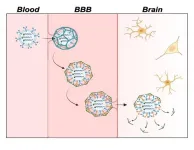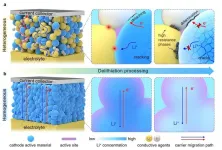(Press-News.org) Chameleon, led by Senior Scientist Kate Keahey from Argonne National Laboratory, has been a cornerstone of CS research and education for nearly a decade. The platform has served over 10,000 users, contributing to more than 700 research publications. Chameleon has now secured an additional $12 million in funding from the U.S. National Science Foundation (NSF) to roll out its next four-year phase. With this new funding, Chameleon will continue to innovate and support its growing community, enabling groundbreaking discoveries in CS systems research.
ABOUT CHAMELEON: A PLATFORM FOR INNOVATION
Chameleon is a large-scale, deeply reconfigurable experimental platform built to support CS systems research. The platform enables a wide range of community projects, from developing new operating systems, virtualization methods, and performance variability studies to power management research, software-defined networking, artificial intelligence, and resource management.
To facilitate such diverse experiments, Chameleon provides a bare metal reconfiguration system, granting users full control of the software stack, including root privileges, kernel customization, and console access. While most testbed resources are configured this way, a small portion is configured as a virtualized KVM cloud. This balance allows for both fine-grained resource sharing and the strong isolation properties of bare metal configurations.
Unlike traditional CS experimental systems typically configured by in-house infrastructures, Chameleon leverages OpenStack, a mainstream open-source cloud technology. This adaptation provides practical benefits, including familiar interfaces for users and operators, workforce development potential, contributions from a community with membership over 2,000 strong developers, and the ability to influence infrastructure used by millions of users. Notably, the Chameleon team played a leading part in contributing the OpenStack Blazar component handling advanced reservations.
As an open testbed, Chameleon has supported over 10,000 users working on more than 1,100 projects since its public availability in July 2015. The platform continues to evolve, with hardware and feature additions documented in its news and blog items.
A NEW PHASE
A significant highlight of Phase 4 is the formal integration of the National Center for Atmospheric Research (NCAR) as an official Chameleon site and partner. NCAR joined the Chameleon project as a volunteer site in January 2022 with a donation of ARM Thunder X2 nodes; NCAR’s new status opens up vast opportunities for collaborations in translational computer science. This partnership is expected to drive advancements in edge computing and edge-to-cloud AI, areas where Chameleon has already made substantial investments and gained significant recognition.
“Innovation in computer science takes place at an accelerating rate, so that if we are not efficient at integrating it, increasingly more opportunities are lost”, said Keahey. “Partnership with NCAR allows us to bring together the communities of computer science and atmospheric science researchers to explore a translational approach where problems in atmospheric sciences drive computer science research, and emergent solutions in computer science are directly translated into capabilities for domain science.”
In response to the increasing demand for Artificial Intelligence (AI) and Machine Learning (ML) research capabilities, Chameleon will be enhancing its infrastructure with the acquisition of new GPUs, including H100s arriving at TACC this fall. This upgrade will bolster support for AI/ML research, enabling more efficient and powerful computational experiments.
For instance, researchers working on large-scale neural networks will benefit significantly from the H100 GPUs, which offer improved performance, faster training times, and the ability to handle larger datasets. This enhancement will facilitate advancements in various AI applications, such as natural language processing, computer vision, and autonomous systems, by providing the necessary computational power to develop and test sophisticated models.
Chameleon’s fourth phase will also see continued efforts in edge computing and the Internet of Things (IoT), building on the successful initiatives from previous phases. The platform will further develop CHI@Edge, which extends support to Single Board Computers (SBCs) deployed outside traditional datacenters. This initiative supports a wide array of experiments, from network fingerprinting to autonomous vehicles, and is essential for advancing research in these cutting-edge areas.
“Testbeds determine what we can experiment with, and thereby shape what science questions we can attack,” explained Keahey. “Extending Chameleon from the datacenter to devices that can be combined with IoT peripherals and cost-effectively deployed at the edge has opened up new areas of exploration, especially for projects that use AI in edge to cloud settings; Chameleon makes such projects easy to deploy in non-prescriptive ways, allowing for a wide range of explorations but also for developing and packaging specific solutions thereby accelerating innovation and adoption of new solutions.“
In addition, Chameleon remains dedicated to supporting reproducibility in CS research. The platform will invest in new tools and methodologies to enhance experimental reproducibility, a crucial aspect of scientific research. Ongoing work in systems innovation will ensure that Chameleon continues to provide state-of-the-art experimental capabilities and hardware options.
Finally, Phase 4 will also focus on modernizing and stabilizing Chameleon’s infrastructure. This includes refreshing and upgrading hardware elements and refactoring testbed software and services to align with the evolving software ecosystem. These improvements are essential for managing the accelerating community growth and ensuring that Chameleon remains a leading platform for experimental methodology development.
A PLATFORM FOR FUTURE DISCOVERIES
Chameleon’s role as a deeply reconfigurable and highly utilized edge-to-cloud testbed is vital for CS systems research, education, and emergent applications. The platform’s configuration as a cloud, with reconfigurability at the bare metal level, is critical for performance or power management experiments. Its robust infrastructure, located at UChicago and the Texas Advanced Computing Center at The University of Texas at Austin, connected by high-speed network links, will continue to support a diverse range of research projects.
“The NSF is pleased to continue funding Chameleon,” said Deep Medhi, Program Director for NSF’s Division of Computer and Network Systems. “This is a great resource for the research community to conduct cutting-edge experimental research.”
For more information about Chameleon, please visit www.chameleoncloud.org.
END
Chameleon testbed secures $12 million in funding for phase 4: Expanding frontiers in computer science research
Chameleon, an experimental testbed for computer science (CS) research, has been awarded $12 million to operate a facility to support computer science research on edge, cloud, and AI. This award, backed by the U.S. National Science Foundation (NSF), brings
2024-07-31
ELSE PRESS RELEASES FROM THIS DATE:
For bigger muscles push close to failure, for strength, maybe not
2024-07-31
When performing resistance training such as lifting weights, there’s a lot of interest in how close you push yourself to failure – the point where you can’t do another rep – and how it affects your results.
While research has looked at this concept in different ways, to date, no meta-analysis has explored the pattern (i.e., linear or non-linear) of how the distance from failure (measured by repetitions in reserve) affects changes in muscle strength and size.
As such, it’s ...
Improving Alzheimer’s disease imaging — with fluorescent sensors
2024-07-31
Neurotransmitter levels in the brain can indicate brain health and neurodegenerative diseases like Alzheimer’s. However, the protective blood-brain barrier (BBB) makes delivering fluorescent sensors that can detect these small molecules to the brain difficult. Now, researchers in ACS Central Science demonstrate a way of packaging these sensors for easy passage across the BBB in mice, allowing for improved brain imaging. With further development, the technology could help advance Alzheimer’s disease diagnosis and treatment.
It is common for neurotransmitter levels ...
Most blood thinner dosing problems happen after initial prescription
2024-07-31
Millions of Americans take anticoagulants, commonly known as blood thinners. These medications work to prevent blood clots that cause heart attack and stroke.
More than two-thirds of those people take a type of blood thinner called a direct oral anticoagulant. DOACs, such as rivaroxaban (brand name Xarelto) and apixaban (brand name Eliquis), are under- or over-prescribed in up to one in eight patents.
These prescribing issues can have life threatening consequences, and they most often occur after a provider writes the initial prescription, according to a study led by Michigan Medicine.
“Direct oral anticoagulants may be viewed ...
AI boosts the power of EEGs, enabling neurologists to quickly, precisely pinpoint signs of dementia
2024-07-31
ROCHESTER, Minn. — Mayo Clinic scientists are using artificial intelligence (AI) and machine learning to analyze electroencephalogram (EEG) tests more quickly and precisely, enabling neurologists to find early signs of dementia among data that typically go unexamined.
The century-old EEG, during which a dozen or more electrodes are stuck to the scalp to monitor brain activity, is often used to detect epilepsy. Its results are interpreted by neurologists and other experts trained to spot patterns among the test's squiggly waves.
In new research published in Brain Communications, scientists at the Mayo Clinic Neurology AI Program (NAIP) demonstrate ...
AI predicts male infertility risk with blood test, no semen needed
2024-07-31
According to a World Health Organization (WHO) study (2017), about half of all infertility is due to men. Semen analysis is considered essential for diagnosis of male infertility, but is not readily available at medical institutions other than those specializing in infertility treatment, and there is a high threshold for receiving it.
In this study, a group led by Associate Professor Hideyuki Kobayashi of the Department of Urology, Toho University School of Medicine, Tokyo, Japan developed an AI model that can predict the risk ...
Researchers pioneer new approach to enhance all-solid-state lithium batteries
2024-07-31
Researchers at the Qingdao Institute of Bioenergy and Bioprocess Technology (QIBEBT) of the Chinese Academy of Sciences, along with collaborators from leading international institutions, have introduced an innovative cathode homogenization strategy for all-solid-state lithium batteries (ASLBs).
This new approach, detailed in their recent publication in Nature Energy on July 31, significantly improves the cycle life and energy density of ASLBs, representing an important advancement in energy storage technology.
Current ASLBs face challenges due to heterogeneous composite cathodes, which require ...
Surprising finding in glioblastomas:
2024-07-31
Glioblastomas are highly aggressive, usually incurable brain tumors. If all therapeutic options are exhausted, patients have an average life expectancy of less than two years. Now researchers from the German Cancer Consortium (DKTK) at the West German Tumor Center Essen have made a surprising discovery: in the vicinity of glioblastomas, they found islands of highly potent immune cells in the neighboring bone marrow of the skull, which play a central role in defending against cancer. The new data may open up prospects ...
Blood proteins may help to track the pathological progression of Lewy’s body disease
2024-07-31
Early detection of Alzheimer’s disease-related changes in Parkinson's disease and dementia with Lewy bodies could be made possible by monitoring the amyloid-β (Aβ) and phosphorylated tau (p-tau) proteins. Researchers at Nagoya University in Japan also discovered the blood levels of neurofilament light chain (NfL) protein is elevated at an early stage of Parkinson's disease (PD) and dementia with Lewy bodies (DLB). This discovery may provide a method to identify potential patients and to make early interventions. The findings were published in npj Parkinson’s Disease.
The two forms of Lewy body disease are PD and DLB. ...
Pandemic exacerbated depression in older adults with diabetes
2024-07-31
TORONTO, ON – A recent study of more than 2,700 older Canadians reported older adults with diabetes faced a heightened risk of depression during the COVID-19 pandemic. In this cohort, almost 50% of those who had a pre-pandemic history of depression experienced depression during the pandemic.
Those who experienced loneliness were among the most impacted.
“During the pandemic, loneliness almost tripled the risk of depression in older adults with diabetes,” says clinical pharmacist and first author ZhiDi Deng. “This not only highlights ...
AI opens door to safe, effective new antibiotics to combat resistant bacteria
2024-07-31
In a hopeful sign for demand for more safe, effective antibiotics for humans, researchers at The University of Texas at Austin have leveraged artificial intelligence to develop a new drug that already is showing promise in animal trials.
Publishing their results in Nature Biomedical Engineering, the scientists describe using a large language model—an AI tool like the one that powers ChatGPT—to engineer a version of a bacteria-killing drug that was previously toxic in humans, so that it would be safe to use.
The prognosis for patients ...
LAST 30 PRESS RELEASES:
Researchers identify gene that calms the mind and improves attention in mice
Artificial metabolism turns waste CO2 into useful chemicals
Ancient sea anemone sheds light on animal cell type evolution
Begging gene leads to drone food
How climate policies that incentivize and penalize can drive the clean energy transition
Can community awareness campaigns in low-resource areas improve early diagnosis of colorectal cancer?
Stardust study resets how life’s atoms spread through space
Practical education: Clinical scenario-based program development
The impact of family dynamics on eating behaviour – how going home for Christmas can change how you eat
Tracing the quick synthesis of an industrially important catalyst
New software sheds light on cancer’s hidden genetic networks
UT Health San Antonio awarded $3 million in CPRIT grants to bolster cancer research and prevention efforts in South Texas
Third symposium spotlights global challenge of new contaminants in China’s fight against pollution
From straw to soil harmony: International team reveals how biochar supercharges carbon-smart farming
Myeloma: How AI is redrawing the map of cancer care
Manhattan E. Charurat, Ph.D., MHS invested as the Homer and Martha Gudelsky Distinguished Professor in Medicine at the University of Maryland School of Medicine
Insilico Medicine’s Pharma.AI Q4 Winter Launch Recap: Revolutionizing drug discovery with cutting-edge AI innovations, accelerating the path to pharmaceutical superintelligence
Nanoplastics have diet-dependent impacts on digestive system health
Brain neuron death occurs throughout life and increases with age, a natural human protein drug may halt neuron death in Alzheimer’s disease
SPIE and CLP announce the recipients of the 2025 Advanced Photonics Young Innovator Award
Lessons from the Caldor Fire’s Christmas Valley ‘Miracle’
Ant societies rose by trading individual protection for collective power
Research reveals how ancient viral DNA shapes early embryonic development
A molecular gatekeeper that controls protein synthesis
New ‘cloaking device’ concept to shield sensitive tech from magnetic fields
Researchers show impact of mountain building and climate change on alpine biodiversity
Study models the transition from Neanderthals to modern humans in Europe
University of Phoenix College of Doctoral Studies releases white paper on AI-driven skilling to reduce burnout and restore worker autonomy
AIs fail at the game of visual “telephone”
The levers for a sustainable food system
[Press-News.org] Chameleon testbed secures $12 million in funding for phase 4: Expanding frontiers in computer science researchChameleon, an experimental testbed for computer science (CS) research, has been awarded $12 million to operate a facility to support computer science research on edge, cloud, and AI. This award, backed by the U.S. National Science Foundation (NSF), brings





